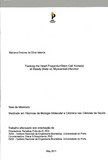Tracking the heart progenitor/stem cell niche(s) at steady-state vs. myocardial-infarction
Résumé
Following ischemic injury, the myocardium undergoes extensive cardiomyocyte loss, scar formation and ventricular remodeling, which can eventually lead to heart failure, a major cause of morbidity and mortality worldwide. Implementation of myocardial infarction experimental models is critical to dissect the pathophysiological mechanisms of left ventricle remodeling and progressive heart failure. Moreover, these models are tools for the identification and validation of novel pharmacological-, and cellular-based cardiovascular therapies, whose ultimate goal is to prevent and/or revert this devastating condition. In the herein work an experimental mouse model of myocardial infarction implemented in our laboratory, by permanent ligation of left anterior descending coronary artery, was validated through histological and functional assessment.
Since the identification of the adult myocardium Sca-1pos, c-Kitpos and/or MDR1pos progenitor/stem-like cells (CPCs), the heart started to be viewed as an organ endowed with self-renewing potential. However, it remains unclear whether and how such cells contribute to cardiac tissue turnover throughout life; there is also an urgent need to clarify the role of the putative adult CPCs under pathological conditions. Therefore, exploratory work was performed to establish solid tools which will allow future detailed studies on the role of cardiovascular progenitor cells in physiological vs. injury scenarios. This will ultimately contribute to the development of novel therapeutic approaches for cardiac regeneration.

